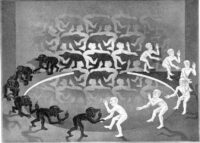Truth can be elusive, so much so that the entirety of the scientific method may be seen as a systematic attempt to find it. Our scientific age, roughly 300 years old, was preceded by uncountable eons of magical thinking and mythology, variously employed to explain both natural phenomena and the course of human events. Clearly, the absence of science as we know it posed no hurdle in humanity’s race to find its future; non-scientific belief systems based upon superstition, religious faith, and tradition fueled ancient efforts as massive as the construction of Egypt’s pyramids and as minuscule as guidance about daily diets.
The scientific method is predicated not so much on proving what’s true, but what’s false. Controlled experimentation is about revealing incorrect assumptions, rendering hypothetical claims to truth as hearsay, false supposition, or failed theory. Even then, truth remains elusive; as the techniques of science improve, what has been taken to be true is frequently revealed as false; time is not fixed, matter is not solid, observation itself alters outcomes.
We live in an age of hyper-specialization, and due to modern scientific advances, most people do not have the skills to fully understand the latest discoveries and conclusions. The mathematical complexity of theoretical physics, quantum mechanics, genetic biochemistry, and the like make it challenging for all but the very few to fully grasp emerging scientific truth; language, reason, common sense, and simple observation are inadequate.
Into this void step our well-worn habits of magical thinking and mythology, tools of explanation we use to make sense of the world. Unable to keep up with specialized science, yet craving explanation, we’re drawn to more accessible answers to relieve our anxiety, even though they offer little in the way of proven solutions or remedies. Scientifically illiterate ideas like injecting bleach or swallowing a livestock de-wormer emerge as antidotes to Covid-19; past mythical remedies included burning witches and avoiding the night air.
Although cultures differ widely in religious and social development, the allure of mythology unites us. Its common features cross linguistic, cultural, and educational borders – belief in an afterlife, for example. Whether in preindustrial or modern cultures, belief in an afterlife is widespread, even while specific descriptions of it vary. Similarly, mythologies about health and diet persist, although they often contradict each other or defy rational explanation. Tomatoes, one of the most widely consumed foods in the world, were once considered poisonous. Even politics is subject to mythology; slogans, rumors, conspiracies, and propaganda foster faith in heroes and villains, the stuff of insurrections.
The myth of the hero, the myth of freedom, the myth of the gods – all myths inhabit the space of human imagination. Imagination allows us to project ourselves into metaphysical space while simultaneously maintaining self-consciousness grounded in physical reality, an activity some neurologists classify a sustained hallucination. This capacity to psychologically occupy two places at the same time facilitates faith in the supernatural but, at its extremes, madness; if widespread, it breeds social chaos and conflict.
Magical thinking goes only so far. That said, scientific rationality and cool reason are not generally as emotionally satisfying, stirring neither the artist or poet nor igniting the public’s senses. Mythology fills that void, too, piloting flights of imagination that stir the soul. So it is that fiction in all its forms excites and entertains us but can also leave us seriously mythtaken.






Reality. What a concept. I enjoyed your take on it. Your article stimulates a pondering of what is. You may consider reading Bernardo Kastrup’s, The Idea of the World. He gives a nod of respect to science for its utility, and then coolly dismantles the logical foundation we assume makes our consensual world, including scientific discovery, real. It is a bit of a slog because it challenges our basic assumptions at every turn, but in the end is quite fun.
Here is another cogent and expansive take on this subject you may find interesting.
From Frank Herberts novel Heretics of Dune, 1987:
“At the quantum level our universe can be seen as an indeterminate place, predictable in a statistical way only when you employ large enough numbers.
Between that universe and a relatively predictable one where the passage of a single planet can be timed to a picosecond, other forces come into play. For the in-between universe where we find our daily lives, that which
you believe is a dominant force. Your beliefs order the unfolding of daily events. If enough of us believe, a new thing can be made to exist. Belief structure creates a filter through which chaos is sifted into order.
Thanks for the thoughtful and intriguing comments, Donna.
I knew when the gods deserted mankind in Das Rheingold and entered Vahala that we were doomed. All in act one of the Ring Cycle! We are now left to our own devices!